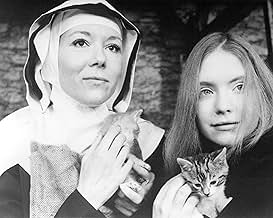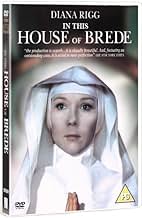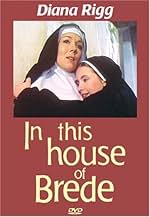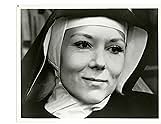Ajouter une intrigue dans votre langueA well-to-do London businesswoman gives up her comfortable life, including the man who loves her, to become a cloistered Benedictine nun.A well-to-do London businesswoman gives up her comfortable life, including the man who loves her, to become a cloistered Benedictine nun.A well-to-do London businesswoman gives up her comfortable life, including the man who loves her, to become a cloistered Benedictine nun.
- Nommé pour 1 prix Primetime Emmy
- 1 nomination au total
Fanny Rowe
- Miss Bowman
- (as Frances Rowe)
Dearbhla Molloy
- Dame Beatrice
- (as Dervla Molloy)
Yasuko Nagazumi
- Mariko
- (as Yasuko Magazumi)
Avis en vedette
In This House of Brede is just about my favorite Rumer Godden novel. However, this adaptation shows the limitations made-for-TV movies labor under better than any other example I could name.
Granted, it's hard to take a 369 page novel spanning more than 20 years and boil it down to something that can be turned into 90 minutes of film. The secret in doing it right is not what you leave, but what you take away and why. In this case, a better job could have been done.
All right; I can see why the whole Duranski subplot went away. It's too hard to film and despite what it reveals about the nuns and their interactions, and how secular people interact with the religious, it does not really advance the plot. Likewise the subplot of Lady Abbess's pectoral cross; it does not really advance the main plot line. Ditto the whole Vatican-II-changes subplot. However, the writer and director did not stop there. In my opinion, deleting the entire Sister Kazuko-Dame Colette plot line was a major mistake; it reduces the entire Japanese novitiate subplot almost to a device. It makes me wonder if the screenwriter missed the whole point of the novel.
The core of the book is about conflicts. Conflicts of self, of want versus duty; conflicts between people; conflicts between the secular and the sacred. Very little of that came through in the final version. Indeed, many of the conflicts were eliminated by the transmogrification of characters. McTurk is gone, with some of his wisdom and understanding grafted onto Sir Richard. Dame Maura is completely eliminated; that was a bad move. The cloying, annoying Dame Veronica has likewise vanished, and with her the conflict between the fluff she writes and the weighty substance of Dame Agnes's work. Dame Agnes herself has been fused with Mother Mistress Emily Lovell in one of the odder recharacterizations I've even seen in a movie, with the result that her edge (Dame Agnes's trademark) is thoroughly blunted. We see the Scallons (Dame Johanna's parents in the movie, Dame Cecily's in the book) only for moments, scarcely long enough to figure out who they are, but not long enough for us to understand why Dame Johanna ended up as she is and where she is. Larry Bannerman, of all the minor characters, is the only one whose part actually illuminated one of the major characters and pointed up best the real conflicts of the religious life as opposed to the secular; far better even than the compare-and-contrast of Philippa Talbot versus Dame Philippa of Brede Abbey.
The best thing about this TV movie is that it points out the crying need for a theatrical feature to be made from this book. It cries for a director with clear vision and a fresco big enough to paint not merely the major portraits, but the miniatures around the edges and in the background. Oh, this 1975 version stands on its own; but it has the same sort of choppiness Cuaron brought to Harry Potter and the Prisoner of Azkhaban, and that does not serve the novel at all well. It requires a slower, more deliberate pace - and above all, a budget big enough that characters do not have to be combined to their detriment, and at least a couple of the plot lines that had to be cut, to be restored.
Even with all these grumbles, there are worse ways to spend an evening than in the company of the nuns of Brede. It's not a bad little movie when all is said and done; it is simply one that could, and should, be done better on the large screen.
Granted, it's hard to take a 369 page novel spanning more than 20 years and boil it down to something that can be turned into 90 minutes of film. The secret in doing it right is not what you leave, but what you take away and why. In this case, a better job could have been done.
All right; I can see why the whole Duranski subplot went away. It's too hard to film and despite what it reveals about the nuns and their interactions, and how secular people interact with the religious, it does not really advance the plot. Likewise the subplot of Lady Abbess's pectoral cross; it does not really advance the main plot line. Ditto the whole Vatican-II-changes subplot. However, the writer and director did not stop there. In my opinion, deleting the entire Sister Kazuko-Dame Colette plot line was a major mistake; it reduces the entire Japanese novitiate subplot almost to a device. It makes me wonder if the screenwriter missed the whole point of the novel.
The core of the book is about conflicts. Conflicts of self, of want versus duty; conflicts between people; conflicts between the secular and the sacred. Very little of that came through in the final version. Indeed, many of the conflicts were eliminated by the transmogrification of characters. McTurk is gone, with some of his wisdom and understanding grafted onto Sir Richard. Dame Maura is completely eliminated; that was a bad move. The cloying, annoying Dame Veronica has likewise vanished, and with her the conflict between the fluff she writes and the weighty substance of Dame Agnes's work. Dame Agnes herself has been fused with Mother Mistress Emily Lovell in one of the odder recharacterizations I've even seen in a movie, with the result that her edge (Dame Agnes's trademark) is thoroughly blunted. We see the Scallons (Dame Johanna's parents in the movie, Dame Cecily's in the book) only for moments, scarcely long enough to figure out who they are, but not long enough for us to understand why Dame Johanna ended up as she is and where she is. Larry Bannerman, of all the minor characters, is the only one whose part actually illuminated one of the major characters and pointed up best the real conflicts of the religious life as opposed to the secular; far better even than the compare-and-contrast of Philippa Talbot versus Dame Philippa of Brede Abbey.
The best thing about this TV movie is that it points out the crying need for a theatrical feature to be made from this book. It cries for a director with clear vision and a fresco big enough to paint not merely the major portraits, but the miniatures around the edges and in the background. Oh, this 1975 version stands on its own; but it has the same sort of choppiness Cuaron brought to Harry Potter and the Prisoner of Azkhaban, and that does not serve the novel at all well. It requires a slower, more deliberate pace - and above all, a budget big enough that characters do not have to be combined to their detriment, and at least a couple of the plot lines that had to be cut, to be restored.
Even with all these grumbles, there are worse ways to spend an evening than in the company of the nuns of Brede. It's not a bad little movie when all is said and done; it is simply one that could, and should, be done better on the large screen.
A professional organist friend of mine at a major cathedral in New York City is interesting in finding out what the organ music was in this movie. Apparently, it is played in fragments, which obviously makes determining what piece it is more difficult. Does anyone have a suggestion as to how to determine the identity of this music? The Music Director, unfortunately, has passed away. I would be grateful for any suggestions as to how to research this issue, before I write directly to BBC to attempt to follow-up. BBC have been very responsive in the past but I thought I would try this forum first. Sorry for the long-winded nature of this query - trying to get in my required ten lines of text.
Almost 20 years before being proclaimed a Dame Commander of the Order of the British Empire, Diana Rigg was portraying a dame of a very different order--that of a fully inducted member of a Benedictine abbey--in the 1975 TV film "In This House of Brede." Perhaps I should mention here that I have not read (Margaret) Rumer Godden's 1969 source novel, and can only comment on the film that I have seen. Many of my fellow reviewers here seem to feel that this televised version cannot hold a vestal candle to its original source, and that does not surprise me; isn't the book always fuller, richer, deeper? Still, what HAS been put on screen still offers much. Here, Diana plays Philippa Talbot, a British businesswoman who has suffered some genuine tragedies in her life and who finds her current lot empty and meaningless. Thus, her application to Brede, where we follow her, over the course of nine years, as she progresses from postulant to novice to junior to dame. Her life at Brede is made complicated by the jealousy and mistrust of elderly Sister Agnes, by the arrival of a group of Japanese girls whom she must instruct, and most especially by the advent of Joanna, a young postulant (well played by Judi Bowker) who arouses Philippa's maternal instincts. Although all the actresses on display here are quite good, it is Diana Rigg, naturally, who takes top honors. How exceptional she is, especially in her emotionally conflicted scenes with Joanna, in her final moments with Agnes, and in her touching scenes with (head Mother) Catherine (again, nicely played by Gwen Watford). Dame Philippa is about as different a role as can be imagined from a certain supersexy secret agent that Rigg had popularized eight years earlier, and to the actress' great credit, she makes a very convincing job of it. Only...just one question from this Jewish reviewer: Do all cloistered nuns wear so much freakin' lipstick?!?
How well I remember this film! I was fifteen years of age and I had read the book. I was attending St Mary's Abbey Grammar School in Mill Hill in Londond when our headmistress gave us the exciting news that a film was to be made in the school. Since it was an all girls school there was as much excitement in the electricians, floor crew, best boys and males in general as there was in the presence of Diana Rigg. To her credit she was very kind to a bunch of tongue-tied schoolgirls and made no objection to our sitting in and watching two of the scenes being shot. I'm not sure if my memory serves me correctly but as far as I recall it was our Sister Maureen who sang for Judy Bowker when she was taking her vows. I doubt we learned much during that time, there were way too many distractions. I saw the film once, many years ago but I really must make an effort to watch it again.
I certainly can appreciate the previous review by the person who very capably compares the book to the movie. But I had not read the book when I first saw the movie years ago on the late show, and I still have not read it. What I have done is stop to watch the movie again and again every time I see that it is coming on. Freed from comparison, the movie is lovely. I have never felt the movie gives a good enough sense of the depth of emotion it seems (to me, at least) would be necessary to impel the main character to make the decision she makes to enter the convent; nonetheless, once the viewer accepts the fact of that decision, the rest of the movie is delightful. Rigg plays her role with clarity, thoughtfulness, circumspection, and elegance. The slow resolution of conflict within the cloistered community is gracefully marked. It is a masterful illustration of patience as virtue. The movie always leaves me with a sense of peace and, finally, joy, although I am not a religious person in the least. I recommend it highly.
Le saviez-vous
- AnecdotesDiana Rigg, Dennis Quilley and Nicholas Clay also appeared together in "Evil Under the Sun"
- ConnexionsFeatured in The 27th Annual Primetime Emmy Awards (1975)
Meilleurs choix
Connectez-vous pour évaluer et surveiller les recommandations personnalisées
Détails
Contribuer à cette page
Suggérer une modification ou ajouter du contenu manquant






























